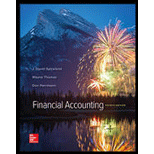
1.
The price of the bonds was issued on January 1, 2014 for $110,465,146.
1.
Explanation of Solution
Calculate the issue price of the bonds.
Working notes:
Calculate the present value of face value of principal
| Particulars | Amount ($) |
| Face value of bonds (a) | $100,000,000 |
| PV factor at an annual market rate of 2.5% for 30 periods (b) |
|
| Present value of face value of principal
| $47,674,268.52 |
Table (1)
Note: The present value of $1 for 30 periods at 2.5% is 0.47674 (refer Table 2 in Appendix).
Calculate present value of interest payments.
| Particulars | Amount ($) |
| Interest payments amount (a) | $3,000,000 |
| PV factor at an annual market rate of 2.5% for 30 periods (b) |
|
| Present value of interest payments
| $62,790,877.78 |
Table (2)
Note: The Present value of an ordinary annuity of $1 for 30 periods at 2.5% is 20.93029 (refer Table 4 in Appendix).
Calculate the amount of interest payment.
2.
The carrying value of the bonds five years later on December 31, 2018.
2.
Explanation of Solution
Calculate the issue price of the bonds.
Working notes:
Calculate the present value of face value of principal
| Particulars | Amount ($) |
| Face value of bonds (a) | $100,000,000 |
| PV factor at an annual market rate of 2.5% for 20 periods (b) |
|
| Present value of face value of principal
| $61,027,094.29 |
Table (3)
Note: The present value of $1 for 20 periods at 2.5% is 0.61027 (refer Table 2 in Appendix).
Calculate present value of interest payments.
| Particulars | Amount ($) |
| Interest payments amount (a) | $3,000,000 |
| PV factor at an annual market rate of 2.5% for 20 periods (b) |
|
| Present value of interest payments
| $46,767,486.86 |
Table (4)
Note: The Present value of an ordinary annuity of $1 for 20 periods at 2.5% is 15.58916 (refer Table 4 in Appendix).
Calculate the amount of interest payment.
3.
The market value of the bonds five years later on December 31, 2018, when market interest rate is 4.5%.
3.
Explanation of Solution
Calculate the issue price of the bonds.
Working notes:
Calculate the present value of face value of principal
| Particulars | Amount ($) |
| Face value of bonds (a) | $100,000,000 |
| PV factor at an annual market rate of 4.5% for 20 periods (b) |
|
| Present value of face value of principal
| $41,464,285.97 |
Table (5)
Note: The present value of $1 for 20 periods at 4.5% is 0.41464 (refer Table 2 in Appendix).
Calculate present value of interest payments.
| Particulars | Amount ($) |
| Interest payments amount (a) | $3,000,000 |
| PV factor at an annual market rate of 4.5% for 20 periods (b) |
|
| Present value of interest payments
| $39,023,809.35 |
Table (6)
Note: The Present value of an ordinary annuity of $1 for 20 periods at 4.5% is 13.00794 (refer Table 4 in Appendix).
Calculate the amount of interest payment.
4.
To Prepare: The
4.
Explanation of Solution
Redemption of Bonds
The process of repaying the sale amount of bonds to bondholders at the time of maturity or before the maturity period is called as redemption of bonds. It is otherwise called as retirement of bonds.
Prepare the journal entry to record early retirement of bonds as on 31st December 2018.
| Date | Account titles and Explanation | Debit | Credit |
| December 31, 2018 | Bonds payable | $100,000,000 | |
| Premium on bonds payable (1) | $7,794,581.14 | ||
| Gain on redemption of bonds (2) | $27,306,485.82 | ||
| Cash | $80,488,095.32 | ||
| (To record early retirement of bonds before the maturity period) |
Table (7)
Working notes:
Calculate premium on bonds payable.
Calculate gain on redemption of bonds.
Yes, this transaction surely, increase the net income $27,306,485.82.
5.
To Explain: Is DP plan is ethical or unethical, and Investors would agree with his plan.
5.
Explanation of Solution
Yes, DP plan is ethical, the early retirement of bonds as on 31st December 2018 of 6% bonds and company get a gain of $27,306,485.82 and he reissue of 9% bonds. According to the investor’s point of view, the gain amount of $27,306,485.82 needs to give a dividend. But DP plans to re-issue new bonds for 9%. Therefore, Investors would probably disagree with CFO plan.
Want to see more full solutions like this?
Chapter 9 Solutions
FINANCIAL ACCOUNTINGLL W/CONNECT >IC<
- Dion Traders has a selling price of $75, variable costs of $60, and fixed costs are $90,000. How many units must be sold to break even? A) 4,500 B) 6,000 C) 3,000 D) 7,500arrow_forwardGeneral accounting questionarrow_forwardIn December 2019, Solar Systems Inc. management establishes the 2020 predetermined overhead rate based on direct labor cost. The information used in setting this rate includes estimates that the company will incur $920,000 of overhead costs and $600,000 of direct labor cost in year 2020. During March 2020, Solar Systems began and completed Job No. 20-78. What is the predetermined overhead rate for year 2020?arrow_forward
- What is the earings per share?arrow_forwardRiverdale Manufacturing purchased a production machine on January 15, 2025, for $82,500. The estimated useful life of the machine is 8 years, and the residual (salvage) value is $7,500. Compute the annual depreciation expense for Year 1 and Year 2 using the straight-line method.arrow_forwardI am searching for the accurate solution to this general accounting problem with the right approach.arrow_forward

 Cornerstones of Financial AccountingAccountingISBN:9781337690881Author:Jay Rich, Jeff JonesPublisher:Cengage Learning
Cornerstones of Financial AccountingAccountingISBN:9781337690881Author:Jay Rich, Jeff JonesPublisher:Cengage Learning EBK CONTEMPORARY FINANCIAL MANAGEMENTFinanceISBN:9781337514835Author:MOYERPublisher:CENGAGE LEARNING - CONSIGNMENT
EBK CONTEMPORARY FINANCIAL MANAGEMENTFinanceISBN:9781337514835Author:MOYERPublisher:CENGAGE LEARNING - CONSIGNMENT Intermediate Financial Management (MindTap Course...FinanceISBN:9781337395083Author:Eugene F. Brigham, Phillip R. DavesPublisher:Cengage Learning
Intermediate Financial Management (MindTap Course...FinanceISBN:9781337395083Author:Eugene F. Brigham, Phillip R. DavesPublisher:Cengage Learning



